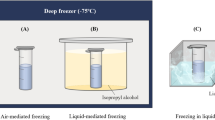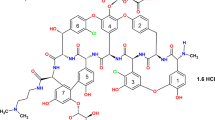Abstract
The purpose of this study was to explore the cryoprotection mechanisms of high molecular weight polyethylene glycols (PEGs) (eg, PEG 4000 and PEG 8000) on lactate dehydrogenase (LDH). Ultraviolet activity assays, circular dichroism (CD) spectroscopy, gel filtration, sodium dodecyl sulfate polyacrylamide gel electrophoresis (SDS-PAGE),14C-PEG 4000 labeling and binding, and cryostage microscopic study were conducted. Different molecular weights and concentrations of PEGs in LDH formulations were treated by freeze-thawing. Higher molecular weights and concentrations of PEGs in LDH-PEG formulations obtained better activity and secondary structure recoveries of LDH after freeze-thawing. Insoluble aggregation of LDH was not observed in gel filtration studies. SDS-PAGE results suggested surface characteristic modifications of LDH by the larger molecular weight PEGs. The14C-PEG 4000 labeling and binding study showed extensive nonspecific interactions between the PEG 4000 and LDH molecules in a concentration-dependent manner. The bound LDH-PEG 4000/free PEG 4000 ratio increased when LDH or PEG 4000 concentrations increased. Cryostage microscopic study showed that PEG 8000 delayed the ice crystallization and eutectic transition of LDH formulation. It appeared that multiple mechanisms were at work during PEGs' cryoprotection of LDH. It was unclear whether the delayed eutectic characteristics of PEGs contributed to LDH cryoprotection. The favorable interaction, rather than preferential exclusion, between LDH and PEGs (eg, 4000) cryoprotected LDH.
Similar content being viewed by others
References
Mi YL, Wood GG, Thoma L, Rashed S. Effects of polyethylene glycol molecular weight and concentration on lactate dehydrogenase activity in solution and after freeze-thawing.PDA J Pharm Sci & Tech. 2002;56:115–123.
Chilson OP, Costello LA, Kaplan NO. Effects of freezing on enzymes.Fed Proc Part III. 1965;15,24(suppl 2):S55-S65.
Prestrelski S, Arakawa T, Carpenter JF. Separation of freezing- and drying-induced denaturation of lyophilized proteins using stress-specific stabilization.Arch Biochem Biophys. 1993;303:465–473.
Arakawa T, Carpenter JF, Kita Y, Crowe J. The basis for toxicity of certain cryoprotectants: A hypothesis.Cryobiology. 1990;27:401–415.
Hartl FU. Molecular chaperons in cellular protein folding.Nature. 1996;381:571–580.
Kurganov BI, Topchieva IN. Artificial chaperon-assisted refolding of proteins.Biochemistry (Mosc). 1998;63:413–419.
Rozema D, Gellman SH. Artificial chaperon-assisted refolding of carbonic anhydrase.B J Biol Chem. 1996;271:3478–3487.
Koseki T, Kitabatake N, Doi E. Freezing denaturation of ovalbumin at acid pH.J Biochem (Tokyo). 1990;107:389–394.
Arakawa T, Timasheff SN. The stabilization of proteins by osmolytes.Biophys J. 1985;47:411–414.
Alden M, Magnusson A. Effect of temperature history on the freezethawing process and activity of LDH formulations.Pharm Res. 1997;14:426–430.
Bradford MM. A rapid and sensitive method for the quantitation of microgram quantities of protein utilizing the principle of protein-dye binding.Anal Biochem. 1976;72:248–54.
Greenfield N, Fasman GD. Computed circular dichroism spectra for the evaluation of protein conformation.Biochemistry. 1996;8:4108.
Lee JH, Lee HB, Andrade J.Progr Polym Sci. 1995;20:1043–1079.
Atha DH, Ingham KC. Mechanism of precipitation of proteins by polyethylene glycols: Analysis in terms of excluded volume.J Biol Chem. 1981;256:12108–12117.
Bhat R, Timasheff SN. Steric exclusion is the principal source of the preferential hydration of proteins in the presence of polyethylene glycols.Protein Sci. 1992;1:1133–1143.
Pace CN. Conformational stability of globular proteins.Trends Biochem Sci. 1990;15:14–17.
Leach BJ, Collawn JF Jr, Fish WW. Behavior of glycopolypeptides with empirical molecular weight estimation methods. 1. In sodium dodecyl sulfate.Biochemistry. 1980;19:5734–5741.
Annunziata O, Asherie N, Lomakin A, Pande J, Ogun O, Benedek GB. Effect of polyethylene glycol on the liquid-liquid phase transition in aqueous protein solutions.Proc Natl Acad Sci USA. 2002;99:14165–14170.
Heller MC, Carpenter JF, Randolph TW. Effects of phase separating systems on lyophilized hemoglobin.J Pharm Sci. 1996;85:1358–1362.
Zaslavsky BY.Aqueous Two-Phase Partitioning: Physical Chemistry and Bioanalytical Application. New York, NY: Marcel Dekker Inc; 1995.
Shalaev EY, Franks F. Changes in the physical state of model mixtures during freezing and drying: Impact on product quality.Cryobiology 1996;33:14–26.
Author information
Authors and Affiliations
Corresponding author
Additional information
Published: September 7, 2004.
Rights and permissions
About this article
Cite this article
Mi, Y., Wood, G. & Thoma, L. Cryoprotection mechanisms of polyethylene glycols on lactate dehydrogenase during freeze-thawing. AAPS J 6, 22 (2004). https://doi.org/10.1208/aapsj060322
Received:
Accepted:
Published:
DOI: https://doi.org/10.1208/aapsj060322




